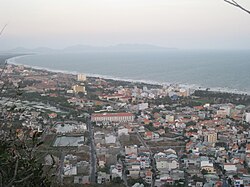Bà Rịa–Vũng Tàu province
Ba Ria–Vung Tau province
Tỉnh Bà Rịa – Vũng Tàu | |
|---|---|
 Vung Tau view from Small Mount | |
 Location of Bà Rịa–Vũng Tàu within Vietnam | |
| Country | |
| Region | Southeast |
| Capital | Vũng Tàu |
| Government | |
| • People's Council Chair | Nguyễn Tuấn Minh |
| • People's Committee Chair | Trần Minh Sanh |
| Area | |
| • Total | 1,987.4 km2 (767.3 sq mi) |
| Population (April 2009)[1] | |
| • Total | 994,837 |
| • Density | 500/km2 (1,300/sq mi) |
| Demographics | |
| • Ethnicities | Vietnamese, Chinese, Chơ-ro, Khmer |
| Time zone | UTC+7 (ICT) |
| Calling code | 64 |
| ISO 3166 code | VN-43 |
| Website | www.baria-vungtau.gov.vn |
Bà Rịa–Vũng Tàu (ⓘ) is a province of Vietnam. It is located on the coast of the country's southeastern region. It also includes the Côn Đảo islands, located some distance off Vietnam's southeastern coast. From 1954 to 1975, this province belonged to South Vietnam.
Administration
Ba Ria–Vung Tau is divided into six districts:
The town of Bà Rịa is a separate municipality, as is the city of Vũng Tàu.
Economy
Ba Ria-Vung Tau provincial economic activities include: petroleum (the most important), electricity at Phu My Power Center and Ba Ria Power Plant (accounting for approx. 40% of the country’s total power capacity), petrochemicals: Phu My Urea Plant (800,000 metric tonnes per year, polyethylene (100,000 metric tonnes/year), steel production, and cement production. Tourism, commerce and fishing are also important economic activities of the province. Ba Ria-Vung Tau contributes greatly to the country’s budget. In 2005, it accounted for around 24% of Vietnam's budget (42,000 billion dong) of a total of 180,000 billion dong (exchange rate is 16,000 dong/dollar), ranking second, after Ho Chi Minh City before Hanoi (28,000 billion dong in 2005). The provincial GDP per capita ranks second to none in the country, over $4,000, if excluding petroleum GDP, it is over $2000 (Ho Chi Minh City ranks second with this index $1,850). However, in term of standard of living, Ba Ria-Vung Tau is third to Ho Chi Minh City and Hanoi. Ba Ria-Vung Tau is also one of the leading direct foreign investment (FDI) attractions of Vietnam, in the top five of FDI acquisition provinces of Vietnam. In tourism, there are some big projects licensed or to be licenced soon: Saigon Atlantis resort (capitalized USD 300 million), Vungtau Aquarium and Bau Trung entertainment park ($500), Xuyen Moc safari ($200)...Vung Tau is an important tourist destination, being particularly well known for its beaches, for its colonial-era architecture, and for a large statue of Jesus on a hill by the sea. Among the most famous tourist destinations are the existing very popular and crowded beaches of Vung Tau and Long Hải and the new up and coming destinations of Ho Tram and Ho Coc located further along the South China Sea coast. The main media agency in the province is the Ba Ria Vung Tau Daily Newspaper.
History
With the exception of the Côn Đảo islands, all of Bà Rịa–Vũng Tàu province was once a part of Dong Nai province to the north. In 1979, Vũng Tàu was broken away from Đồng Nai and merged with the Côn Đảo islands (formerly part of Hau Giang province), forming the new Vũng Tàu–Côn Đảo “special zone”. Later, in 1992, Bà Rịa was also broken away from Dong Nai province, merging with Vung Tau–Con Dao to form the modern province of Ba Ria–Vung Tau.

